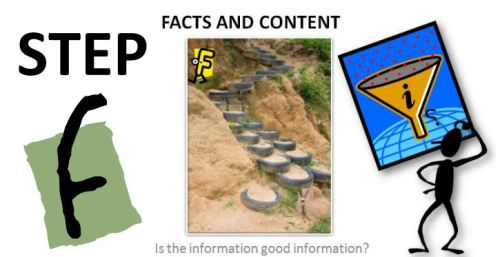Step F:Seven Steps To Website Evaluation For Students - Facts And Content

Quick Note I have been getting a lot of requests asking if I will make a visit to your school, organization, or conference. Please be aware that I am available to assist you in providing professional development and presentations. I have had the opportunity to network in person across the country and invite your inquiry at my booking information page and at mjgormans@gmail.com. Please note that I do need plenty of advance notice as my schedule does fill quickly.
Visit the four prior website evaluation posts: A if for Author … B is for Bias … C is for Currency… D is for Domain Anatomy… E is for Effectiveness For Purpose… (Just click on the letter)
The Seven Steps to Web Site Evaluation – Step F
Welcome to the web site evaluation page evaluation series of posts. As I speak with educators across the nation I find there is a need for all teachers to emphasize proper web site evaluation by students. As part of my Digital Native/Digital Immigrant Presentation I call on Digital Immigrants (You and Me) to use their life long experience and education to show Digit ital Natives (Our students), how to make the best use of information they find on the web. In fact finding the information is a whole other topic and you can learn in some future posts.
I believe that web evaluation must be a simple process that can also be applied to memory. Thus the reason for my (A-G) approach. This series is devoted to teaching these skills and I have spent hours preparing resources that you are free to use. I have divided this series using my A-G approach. Please, if you ever have the opportunity, visit me at one of my conference presentations, check out one of my webinars, or invite me to your school district to help inform your entire faculty. It really is time to help kids understand that there are no whales in Lake Michigan, the Southwest Tree Octopus is nonexistent, study of cats and bearded men did not really happen, moon creatures failed to film the lunar landing, and Columbus was not born in Australia. Please enjoy, share, and use!
F Is For Facts And Content
The facts and content provided on a website are, after all, the reason a researcher is visiting that site. It is important before using material gathered from a site that all facts and content be validated.
1. Properly Verify The Information – Determining validity of a website is the process of verifying the information. This can include copying and pasting facts into a search engine and finding other sites that provide similar information. Any content should be validated from at least two or three other reputable sources. These sources could include multiple reference genres including other web sites, databases, or print references. It is always wise to find at least one scholarly source that confirms information gathered from a site. Using this method will not only allow for reliable research, but will also provide other reference and resource materials that can be used in the final product.
Tools and ideas to transform education. Sign up below.
2. Proper Grammar – Information and content are important, but just as important is the grammar used in the article or web page being cited. Poor grammar may indicate a page that may also contain poor research with incorrect facts and content. Even if the resource seems to have good information, citing a publication that contains poor grammar will lead to a lack of credibility by anyone reading the article citing such a source. It may be a good practice to use facts that may seem credible only after finding another source that confirms such facts and content without the grammatical errors.
3. To The Point Or Is It Vague? – It is important to use resources that are able to provide information that is concise and to the point. Oftentimes information that is vague and filled with needless words may lack reliable content. In fact, vague writing sometimes points toward possible bias or lack of adequate research. Preparing a final presentation will best be served when using sources that are direct and to the point.
4. Good Word And Sentence Flow – This idea runs parallel to the idea of using a site that is constructed using proper grammar. The resource should present content in a manner that is direct and to the point. Trying to interpret poor sentence structure may indicate unreliable information or may lead to misinterpretation of the content. The research process would be a cumbersome journey if these types of sites were used to prepare a presentation.
Download Poster Here: f1_poster_info
Enjoying the series?… Please let me know by email, response, and sign up… and please share with a Retweet!
Thank you for joining me and if you have an idea that you feel is important please leave a comment or pass it on to me in an email. I hope you found this information something you can use in your school and to share with other educators. As always , I invite you to follow me on twitter (@mjgormans). Please give this post a retweet and pass it on to someone who will benefit. To ensure you do not miss a future valuable post or other resource covering PBL, Digital Curriculum, STEM, 21st century learning, and technology integration please sign up for21centuryedtech by email or RSS. Have a great week… enjoy the Discussion! – Mike (http://21centuryedtech.wordpress.com/)
cross-posted at 21centuryedtech.wordpress.com
Michael Gorman oversees one-to-one laptop programs and digital professional development for Southwest Allen County Schools near Fort Wayne, Indiana. He is a consultant for Discovery Education, ISTE, My Big Campus, and November Learning and is on the National Faculty for The Buck Institute for Education. His awards include district Teacher of the Year, Indiana STEM Educator of the Year and Microsoft’s 365 Global Education Hero. Read more at 21centuryedtech.wordpress.com.
